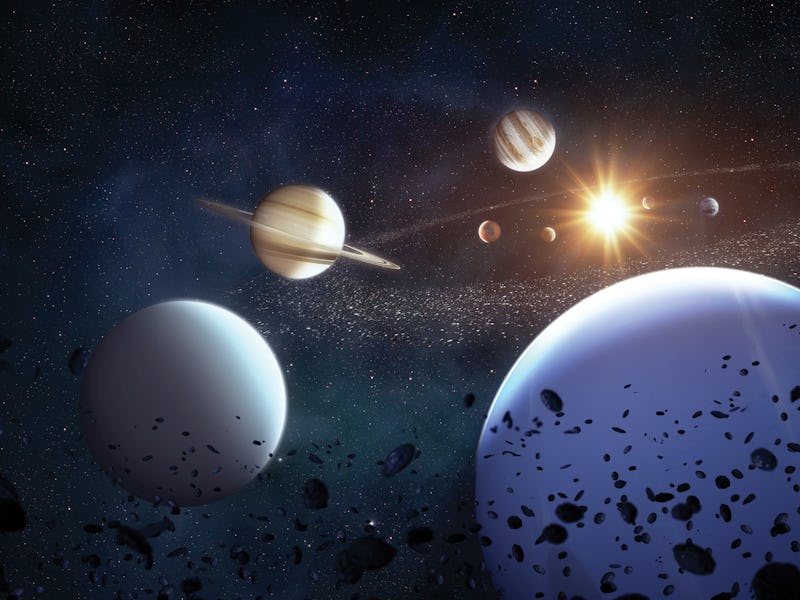Mercury is the Kelly Clarkson of planets. Here's why.
Stay up to date with the latest cosmic gossip from across the universe.

The names that we attribute to celestial objects originate from the names of famous figures from Ancient Greeks, Romans and Egyptians.
But perhaps it is time for an update. Rather than ancient gods and mythical warriors, we should consider renaming some of these cosmic beings after the icons of today. Inverse has put together a list of cosmos to pop culture comparisons that will keep you up to date with the latest of what's happening in our universe.
Oumuamua is the Naomi Campbell of interstellar objects
In September, 2017, our world was visited by a beautiful, elongated object that didn't fit into anything we had seen before. Oumuamua, which means "A messenger from afar arriving first" in Hawaiian, was the first recorded interstellar object to cruise through our Solar System and has fascinated scientists ever since.
However, they weren't quite sure how it formed or where it came from. But a new study suggests that Oumuamua is a giant chunk of frozen hydrogen ice that was expelled from a massive molecular cloud.
Oumuamua is sort of like the Naomi Campbell of interstellar objects, beautiful, mysterious and a little cold. The pair have inexplicable physical traits that leave people dumbfounded, Oumuamua's elongated, cigar-like shape and Campbell's long legs, and they both seemingly come from a different world of their own. Campbell's runway skills and supermodel aura are unmatched until today.
But just as Oumuamua is seemingly made of ice, Campbell can also have similar tendencies. Flashback to Campbell's interview with Tyra Banks in 2005 on They Tyra Banks Show (this is daytime television deep-cuts) when Banks confronted her in tears about their rivalry, and Campbell was seemingly unmoved.
Despite what they may be made of on the inside, Campbell and Oumuamua still have plenty more to offer to the world.
Read more about Oumuamua's origin story.
The Martian moons are the Olsen twins of natural satellites
Although Mars gets a lot of hype in the Solar System, its two orbiting moons do not. Deimos and Phobos are small, misshapen moons that appear to be made up of the same material that makes up asteroids found in the outer asteroid belt. In fact, following the pair's discovery in 1977, scientists believed them to be asteroids that had been captured by Mars' gravitational force.
A new study suggests that Mars has a moon-ring cycle, whereby over the billions of years of Mars' existence, a number of moons had been pulled apart by Mars' gravity and created a ring around the Red Planet, from which a newborn moon would be created.
These tiny, seemingly insignificant moons are the Olsen twins of natural satellites, odd, petite and created during a vicious cycle of child celebrities. Deimos and Phobos share a lot of similarities with Mary-Kate and Ashley Olsen, we may have forgotten about them for a while but they're still out there.
Although you can't really tell them apart, both the moons and the sisters are quite different from one another, with Deimos on an outward orbit around Mars and has a smoother surface than its sibling satellite, while Phobos has larger craters. The same way Mary-Kate is the edgier of the twins, and Ashely is the deep, thoughtful one.
These siblings seem to always be around each other, well one of them is bound by planetary orbit while the other pair is just weirdly inseparable.
Read more about the cycle that creates Martian moons.
ASTERIA is the Leslie Jordan of CubeSats
A briefcase-sized satellite named ASTERIA just broke the record for the smallest satellite to detect an exoplanet. ASTERIA, short for Arcsecond Space Telescope Enabling Research in Astrophysics, wasn't initially designed to perform any science. Instead, the CubeSat, a type of miniaturized satellite made up of multiples of 10 cm × 10 cm × 10 cm cubic units, was launched to research new capabilities for future missions.
But this tiny satellite proved for itself and its miniature comrades that it was worth more, detecting exoplanet 55 Cancri e, a super-Earth planet that's about twice the size of Earth and orbits extremely close to its host star.
The same way the CubeSate came through for a super-Earth, actor and comedian Leslie Jordan also came through for our planet Earth during its hardest time, providing comic relief through his social media platform and proving that he's more than his guest-starring roles.
Jordan became famous for his videos that he started posting during the national lockdown in March, which gained him a lot of popularity among people who weren't aware of his comedic genius the same way ASTERIA was capable of pulling off a job it wasn't initially set out to do.
Both of these petite heroes are a ray of sunshine amidst hard times.
Read more about the tiny CubeSat that could.
Mercury is the Kelly Clarkson of planets
'Oh right, they're still there,' is the reaction most people give to both the innermost planet of the Solar System, Mercury, and singer Kelly Clarkson.
Both of these icons come first, Mercury is the closest planet to the Sun and Clarkson is the first winner of the singing competition, American Idol. But sadly, we often forget about them until they sort of show up again.
It's Mercury.
Mercury will be visible this weekend in the night skies as it reaches its longest elongation, or furthest distance from the Sun, while Clarkson made an odd appearance at the SpaceX launch this past weekend, singing the National Anthem over a webcast.
Keep shinning, Mercury and Clarkson. Although, we can't guarantee we'll always see you.
Read more about the planet Mercury's rare elongation.